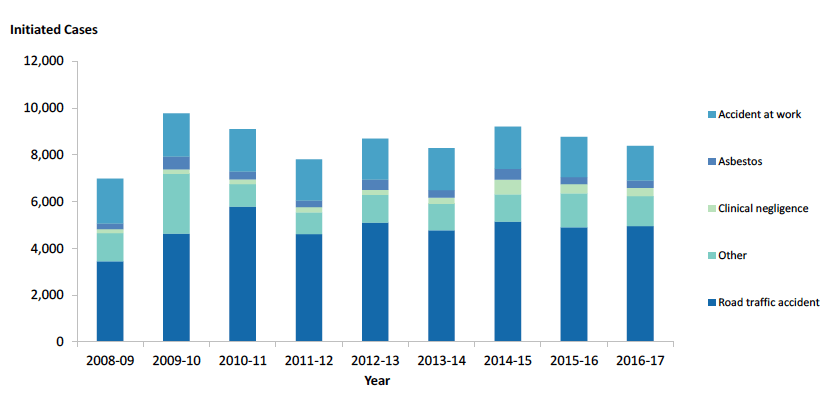Civil justice statistics in Scotland: 2016-2017
The 2016-17 Civil Justice in Scotland release includes main statistics tables and figures and supplementary statistics tables.
This document is part of a collection
8. Personal injury
There was a 4% decrease in personal injury cases initiated in 2016-17 compared to 2015-16
Just over 35% of personal injury cases were raised in the recently established Sheriff Personal Injury Court
Over three in five personal injury cases were in relation to a road traffic accident
Personal injury in Scotland
Personal injury can be physical and/or psychological, and include disease or impairment. Personal injuries may result from a wide range of causes including an injury received at work, a traffic accident, or through negligence or a deliberate act on the part of another party. A person who has suffered an injury can seek redress through several routes, such as making a complaint against the person/organisation they consider to be responsible for the injury, seeking assistance with any financial problems they have as a result of their injury, or seeking counselling. Alternatively, they may wish to claim compensation, provided certain criteria are met to cover losses they have suffered as a result of the injury.
A personal injury case is a form of damages case that relates specifically to damages for, or arising from, personal injuries or the death of a person from personal injuries. Personal injury actions do not cover defamation or any actions which are not commonly understood to be concerned with personal injuries. Such actions are covered in the Damages section of this bulletin.
Personal injury cases made up 11% of all civil court cases initiated in 2016-17 (Table 13, Table 1). This includes the cases going through the recently established Sheriff Personal Injury Court.
Scottish Crime and Justice Survey
The 2016-17 Scottish Crime and Justice Survey found that an estimated 2% of respondents experienced a medical negligence issue and 1% experienced a personal injury problem in the last three years.
Courts statistics
There were 8,378 personal injury cases initiated in 2016-17, 4% fewer than in 2015-16 (Table 13). The number of personal injury cases has fluctuated since 2008-09. The type of court where personal injury cases can be raised has recently changed under the Courts Reform (Scotland) Act 2014, particularly with the establishment of the specialised Sheriff Personal Injury Court. See the Courts Reform section for more detail. Compared to 2015-16, in line with the legislative aim of the Court Reform (Scotland) Act 2014, the number of personal injury cases initiated in the Court of Session decreased by approximately 1,600 cases or 74% (Table 14, Civil Justice Statistics in Scotland 2015-16 Table 14). In the sheriff courts, cases initiated under ordinary cause decreased by approximately 500 cases or 21% and those under summary cause by approximately 100 or 3%. Thirty five per cent (2,956) of all personal injury cases were initiated in the new Sheriff Personal Injury Court in its first full financial year (Table 1).
In every year since 2008-09, cases resulting from a road traffic accident made up the greatest proportion of personal injury cases, accounting for 59% in 2016-17. The fluctuation in road traffic accident related cases over time (Figure 10) contrasts to the downward trend in the number of reported road traffic accident casualties[10].
Figure 10: Personal injury cases by case types

After reaching a peak of 629 cases in 2014-15, the number of clinical negligence cases has been decreasing and reached 351 cases in 2016-17 (10% decrease from 2015-16). This remains higher than the approximately 200 cases a year raised from 2008-09 to 2013-14. In the Court of Session, where 55% of clinical negligence cases were raised, the decrease was 31% (from 280 cases in 2015-16 to 193 cases in 2016-17) (Table 14, Civil Justice Statistics in Scotland 2015-16 Table 14).
In 2016-17 there was a 5% rise in the number of asbestos cases initiated compared to the previous year, to 316 cases. This is approximately 60% of the number of cases initiated in 2009-10 (541 cases). The peak in 2009-10 can be explained in part by the introduction of the Damages (Asbestos-related Conditions) (Scotland) Act 2009, which came into force in June 2009 and allows individuals with asbestos-related pleural plaques etc. to raise a court case for personal injury.
Many asbestos cases were sisted (suspended) pending the UK Supreme Court's decision as regards a judicial review of the Damages (Asbestos-related Conditions) (Scotland) Act 2009. Following the decision of the UK Supreme Court dated 12 October 2011 in the case Axa General Insurance Ltd & Others v The Lord Advocate, direction no. 2 of 2012 was made by the Lord President on 27 August 2012 outlining the procedures to be followed in the relevant cases, and disposals have since progressed accordingly.
Across all categories of personal injury cases in the Court of Session, absolvitor was the most common disposal, accounting for nearly four-fifths of all cases disposed of (Table 14). Absolvitor means that the pursuer is prevented from bringing the same matter to court again, in some of these cases the parties involved would have come to an out-of-court settlement.
In 2016-17, personal injury actions were raised in court in the following proportions (Tables 13 to 17): Court of Session (6%), sheriff court ordinary cause procedure (25%), sheriff court summary cause procedure (34%) and Sheriff Personal Injury Court (35%).
From a total of 2,956 cases, accident at work (1,135) and road traffic accident (832) made up the majority of cases raised in the new Sheriff Personal Injury Court (Table 17). Over the same period, 1,363 cases were disposed of, with accident at work and road traffic accidents again making up the largest proportion.
Contact
There is a problem
Thanks for your feedback